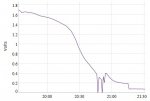Hi,
the answer is that there is not a replacement for the LDR.
IMHO that's unlikely, but you might need to use somewhat different circuitry.
The CPC link doesn't appear to quote the sensitivity, but it's probably similar to the "classic" ORP12. That has a resistance of about 300 kohms at 1 Lux, which is probably approximately what you've been using. A photodiode like the BPW34 has a reverse photo-leakage current of around 100 nA at 1 Lux, which should be sufficiently above its maximum thermal leakage current, at least up to perhaps 50 degrees C. 100 nA corresponds to 1 mV across 10 kohms, whilst the PICaxe READADC10 command resolves down to 2 mV (with the FVR reference set to 2 volts). So not quite "good enough", but you could probably increase the resistor to, say, 47 kohms in practice. At the mV level you just might need to consider thermo-electric effects in the circuit.
Alternatively, the ST-7L phototransistor (to which the LED022 phototransistor sold by Rev Ed is said to be similar) conducts a nominal current of about 4 uA at 1 Lux, which could be an ADC10-bit value of around 20 across 10 kohms. The actual sensistivity will have a considerable range (maybe as high as 40 : 1 according to the data sheet) but that could be "calibrated" within the PICaxe. Note that although the LED022 has a "peak" response in the IR range (as do most silicon junctions) it still has adequate sensitivity in the visible range.
However, if you want a "fail safe" design (i.e. one that always activates in zero light level), then using the photoelectric effect might be better (because that must be zero in darkness). It will need a "large area" sensor, either a specialised photodiode, or maybe a small PV (solar) panel. Perhaps even a panel from a "Pound Shop" solar garden light. They are usually Amorphous Silicon which do suffer "ageing" effects (perhaps by a factor of a half, or so) but being deposited behind glass could help the general "environmental" issues such as UV. Amorphous silicon also has its peak response in the visible part of the spectrum (as do LDRs).
Cheers, Alan.

